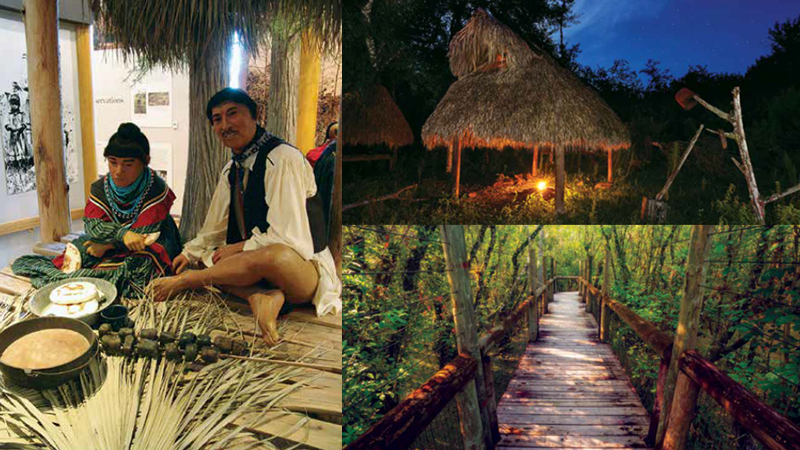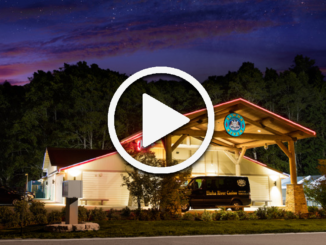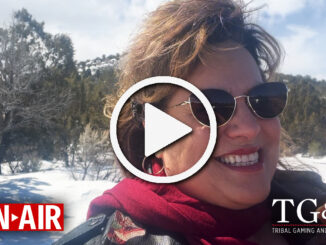Article by Karie Luidens for the American Indian Alaska Native Tourism Association Cultural Heritage Tourism, A planner for indigenous tourism professionals
The Seminole Tribe of Florida is as deeply rooted in their homeland as the Everglades itself. Like the region’s famous sawgrass marshes, the Seminoles and their ancestors have thrived in the peninsula’s tropical climate for thousands of years.
These days, as balmy weather draws visitors from around the world, the Seminole people invite travelers to learn more about their heritage through several tribally owned operations under Florida Seminole Tourism. Big Cypress RV Resort provides camping sites, cabins, an outdoor pool and related amenities; Billie Swamp Safari offers animal exhibits and guided wetlands tours on airboats and swamp buggies; while the Ah-Tah-Thi-Ki Museum presents Seminole history, culture and perspectives on contemporary issues.
The question of interpretation is critical throughout. How do Seminole communities tell their stories through these attractions?
Prioritizing the Needs of the Seminole People
Dante Blais-Billie, Seminole citizen and assistant director of the Ah-Tah-Thi-Ki Museum, explains that visitor-facing institutions must, first and foremost, prioritize the needs of the Seminole people.
“It’s really about preserving the agency of our Tribe,” she said. “When we’re looking at decolonizing what cultural tourism is, it’s about respecting the boundaries of what the tribal members want to show.”
When we’re looking at decolonizing what cultural tourism is, it’s about respecting the boundaries of what the tribal members want to show.
This means that every exhibit and activity on offer is subject to the approval of Seminole tribal members through both formal and informal channels.
Formal Tribal Oversight
All of Florida Seminole Tourism’s operations are overseen by the Tribal Council, which includes representatives from each of the Tribe’s six reservations. The Council has approved current programming and no significant changes can take place without official authorization.
For Billie Swamp Safari and Big Cypress RV Resort, which focus on experiences of the landscape and wildlife, day-to-day functioning is generally consistent (temporary pandemic-related closures notwithstanding). However, at the Ah-Tah-Thi-Ki Museum, new rotating exhibits and an ever-growing collection require regular oversight to ensure that decision-making is culturally appropriate.
This oversight is conducted by several committees that bring together both museum team members and tribal community members. The Museum Advisory Committee (MAC) reviews the content and verbiage of public displays, while the Acquisitions Committee handles the acquisition of new items for the permanent collection, and the Tribe’s NAGPRA Committee ensures the wider Southeastern collection remains in co-ordinance with the Native American Graves Protection and Repatriation Act.
While museum staffers offer curatorial expertise regardless of tribal affiliation, it’s critical that these committees include the perspectives of multiple Seminole tribal members and their lifelong cultural knowledge.
“One of the main messages of our museum is that Seminole culture is widely diverse,” Blais-Billie notes. “We have different clans. We have different beliefs and customs, amongst even just two families within the same clan. We’re always aware of having that kind of diversity among our tribal member advisors, to make sure that all groups of the Tribe are being represented.”
Informal Community Relationships
In addition to the formal oversight of the Tribal Council and relevant committees, the Ah-Tah-Thi-Ki Museum, Billie Swamp Safari, and Big Cypress RV Resort all benefit from their sheer proximity to the Seminole citizens they serve on the Big Cypress Reservation.
“You drive through the neighborhoods of these tribal members when you come to our attractions,” Blais-Billie said. “We’re amongst our community members, and part of that community.”
She emphasizes that Seminole people are encouraged to use the museum as a resource for exploring their own heritage and identities, and to engage freely with staff during their visits.
“A tribal member can always feel comfortable and safe to reach out to staff, even if we’re just standing in the museum, and say, for example, ‘I don’t know if you’ve gotten a perspective from Bear Clan about this object, but I don’t think that this should be preserved this way,’” she said.
“We’ve never actually gotten to that stage,” she added, “because before that would ever happen, we already take those precautions really far in advance.”
Hiring and Training
From official procedures to casual visits, the engagement of Seminole tribal members is particularly important because the majority of employees at the attractions are not themselves Seminole.
Across visitor operations as well as other departments, the Seminole Tribe of Florida has a hiring preference first for Seminole tribal members, followed by citizens of other Native nations. They also run job fairs and work experience programs to recruit Seminole youth and mentor them in their fields of interest.
The Ah-Tah-Thi-Ki Museum in particular offers a work experience program in which Seminole teenagers from the nearby Ahfachkee School gain on-the-job mentoring in areas like archaeology, collections management and conservation for class credit. In addition, Seminole students from any school can secure a paid internship with the Museum through the Seminole Tribe’s Student Work Experience Program (SWEP). The Tribe has seen participants of these programs go on to work full-time for related departments.
The Ah-Tah-Thi-Ki Museum offers a work experience program in which Seminole teenagers from the nearby Ahfachkee School gain on-the-job mentoring in areas like archaeology, collections management and conservation for class credit.
Even with these programs in place, at this time much of the tribe’s visitor-facing workforce is non-Native. To ensure staff are prepared to reflect well on the Seminole Tribe, as of 2019 all new hires are required to participate in a museum tour and cultural training conducted by the Ah-Tah-Thi-Ki Museum’s education coordinator.
This is true regardless of individuals’ tribal citizenship or background – and not just for standard customer service roles, but every position from accounting to construction management. Even if certain employees don’t require cultural knowledge to perform their duties, they’re expected to be respectful representatives of the Tribe both on and off the job.
“We’re ambassadors of the Seminole Tribe of Florida,” said Carrie Dilley, marketing and advertising coordinator of Florida Seminole Tourism. “At every step, we need to make sure that we’re representing the Tribe the way the Tribe would want to be represented. We work for the Tribal Council, but by the same token, we have more than 4,000 employers – the individual Seminole tribal members.”
Serving the Tribe
When it comes to cultural tourism, “authenticity” is often top of mind for both site operators and visitors. After all, no one wants to engage in encounters that are inaccurate or exploitative.
On the other hand, “authenticity” may connote capturing a moment in history to preserve under glass, rather than meeting communities on contemporary terms.
For her part, Blais-Billie sees the Ah-Tah-Thi-Ki Museum as a place not only for visitors to learn about Seminole history, but for Seminole people to host an ongoing discourse about their present and future. Whereas outside institutions may invite them to contribute exhibits on the vague theme of “Seminole identity” or “Seminole culture,” they can use this space to curate programs that focus on more granular subjects of interest, as with a recent exhibit on tattooing.
“The Ah-Tah-Thi-Ki Museum [is] a place not only for visitors to learn about Seminole history, but for Seminole people to host an ongoing discourse about their present and future.”
“At the end of the day, our entire purpose is to serve the Tribe in whichever way they see fit,” she said. “If tomorrow the entire Tribe decides they don’t want us to do what we’re doing now, we have to go back to the drawing board and figure out how we can be the best institution we can be for them.”
For now, a combination of proximity, formal oversight and general community engagement ensures that Florida Seminole Tourism is offering visitors an immersive Everglades experience that’s mutually beneficial for all involved.
Empowering Artisans in the Shade of Chickees
Since the local ecosystem is fundamental to Seminole culture, no visit to their homeland would be complete without experiencing the Everglades. That’s why the Ah-Tah-Thi-Ki Museum offers a mile-long boardwalk through a 66-acre cypress dome.
Along the way, visitors pass a chickee village reminiscent of encampments built through the early 1900s. The chickees provide shade for several Seminole artisans working on crafts like sweetgrass basket-weaving. These individuals offer not only goods for sale, but the opportunity for visitors to chat and ask questions about their work.
Unlike staff elsewhere across the Seminole tourism attractions, the artisans in the chickee village are exclusively tribal members who have been recruited for their lived experiences and traditional skills. Because the museum’s goal is to empower traditional artisans, they each set their own schedules and sell their wares directly.
About the Writer
Karie Luidens is an Albuquerque-based writer of criticism, commentary, current events and semi-connected musings. She originally hails from Upstate New York and Michigan but has made the high desert of New Mexico her home since 2015. Between writing projects, she also dabbles in drawing and graphic design of all kinds.
Originally published in Cultural Heritage Tourism: A Planner for Indigenous Tourism Professionals, produced by the American Indian Alaska Native Tourism Association.




